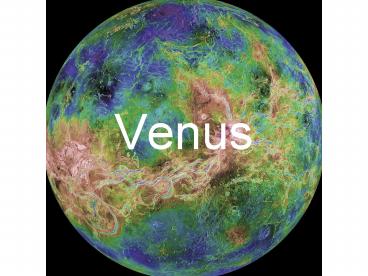Venus PowerPoint PPT Presentation
1 / 17
Title: Venus
1
Venus
2
Venus Data
3
Guiding Questions
- What makes Venus such a brilliant morning star
or evening star? - What is strange about the rotation of Venus?
- In what ways does Venuss atmosphere differ
radically from our own? - Why do astronomers suspect that there are active
volcanoes on Venus? - Why is there almost no water on Venus today? Why
do astronomers think that water was once very
common on Venus? - Does Venus have the same kind of active surface
geology as the Earth?
4
Brilliant Morning Star and Evening Star
- At its greatest eastern and western elongations,
Venus is about 47 from the Sun
- Morning Star
- at greatest western elongation
- rises nearly 3 hours before the Sun
- High in the eastern sky at dawn
- Evening Star
- At greatest eastern elongation
- High above the western horizon after sunset
5
Brilliant Morning Star and Evening Star
- It is the brightest object in the sky except the
Sun and the Moon - Venus is relatively large
- Close to the Sun
- Close to the Earth
- Strongly reflect the Sunlight by its cloudy
atmosphere
6
Thick Cloud Cover of Venus
- Venus is similar to the Earth in its size, mass,
average density, and surface gravity - It is covered by unbroken, highly reflective
clouds that conceal its other features from
Earth-based observers
Crescent Venus The ring indicates atmosphere
Cloudy Venus
7
Peculiar Rotation
- Rotation is retrograde rotation is opposite of
the direction of orbital motion - Orbit motion around the Sun counterclockwise
- Venuss rotation on its axis clockwise
- Planets and satellites have prograde rotation
except Venus, Uranus and Pluto
8
Atmosphere
- Measured by Spacecraft and their landing probes
- Composition
- Mostly carbon dioxide 96.5
- Remaining is Nitrogen 3.5
- Surface Temperature 460C in both dayside and
night-side - Density
- Very high, 90 atm at the surface
- Both temperature and pressure decrease as
altitude increases
9
Atmosphere
- Dense greenhouse gas CO2 raises the surface
temperature by more than 400C - Venus has three layers of high-altitude clouds
from 48 km to 68 km - Venuss clouds consist of droplets of
concentrated sulfuric acid (H2SO4 highly
corrosive).
10
Venuss Clouds
- Sulfuric acid in the clouds come from the
sulfurous gas injected into the atmosphere by
volcano - Hot-spot volcanism a hot region beneath the
planets surface extrudes molten rock over a long
period of time, e.g., the Havaiian volcanoes - Ongoing volcanic activity
- Unexpected high level of sulfuric acid in 1978,
and steadily declined over the next years - Clouds may be replenished by active volcanoes
Mount St. Helens Earth, 1980
11
Venuss Clouds
- Relatively young lava flows are seen from
volcanoes - The lack of craters on the surface suggests that
the entire surface of Venus is no more than a few
hundred million years old.
Venusian Volcano by Radar
12
Climate Evolution
- Venus versus Earth Similarities
- Venus and Earth are similar in size, mass,
density and surface gravity - The early atmospheres of both Venus and Earth
were similar in content water vapor (H2O),
carbon dioxide (CO2) and Sulfur dioxide (SO2)
that have outgassed from volcanism - Venus versus Earth Disparities (now)
- The Earth has abundant water in its oceans and
little carbon dioxide in its relatively thin
atmosphere - The Venus is very dry and its thick atmosphere is
mostly carbon dioxide
13
Climate Evolution
- On the Earth, H2O and CO2 are recycled
- Water Vapor falls as rain, forming the oceans
- CO2 dissolves in the water, falling into the
ocean - CO2 and H2O are incorporated into sedimentary
rocks - As a result, most CO2 is removed from the
atmosphere, and locked into the Earths rocks.
14
Climate Evolution
- On the Venus, the atmosphere experienced a
runaway greenhouse effect - In the early history, it may also have liquid
ocean
- But temperature is relatively higher, the
atmosphere has relatively more water vapor - The greenhouse effect of the water vapor raised
the temperature, and more liquid water evaporated - This further intensified the greenhouse effect,
and raised the temperature even higher - This runaway process continued until oceans
disappeared - Almost all of the water vapor was eventually lost
by the action of ultraviolet radiation on the
upper atmosphere
15
Climate Evolution
- Without ocean to dissolve in, the outgassed CO2
would accumulate in the Venuss atmosphere
- The Earth has roughly as much carbon dioxide as
Venus, but it has been dissolved in the Earths
oceans and chemically bound into its rocks
16
Surface
- The surface of Venus is surprisingly flat, with
only a few major highlands and several large
volcanoes - The surface of Venus shows no evidence of plate
tectonics (or the motion of large crustal plates) - No long chain of volcanic mountains
17
Interior
- No seismic data available to give a definite
answer - The presence of volcanisms suggests a molten
interior - Venus has no planet-wide magnetic field, possibly
due to the fact that Venus rotates too slow
- Venus has no plate tectonics, possibly due to
that the crust is too hot and soft to move in
rigid plates

